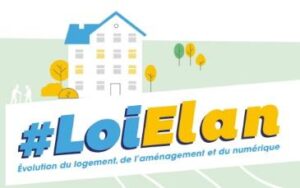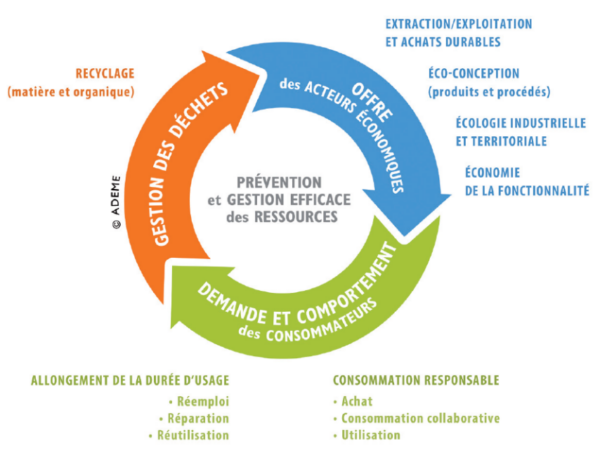The circular economy
Home » INIES for building » The circular economy
The issues for developing a circular economy are high. Indeed, buildings, as well for their construction as for their operation, currently represent 40% of the European energy consumption and more than 50% of the raw materials extracted. In France, the building sector generates approximately 42 million tonnes of waste each year, more than households (30 million tonnes) but 4 to 5 times less than public works (185 million tonnes). Almost all of this building waste (93%) comes from demolition/rehabilitation work, new construction representing the balance.
The context of environmental transition of the building, led by various legislative texts and national experiments, imposes a significant reduction of the environmental impacts, in particular carbon, of construction works. The ELAN law (or housing law 2018) reflects the “housing strategy” of the government and prepares the environmental regulation, the RE2020, by defining the energy and environmental performance and by aiming to reduce the carbon footprint of new buildings on their entire life cycle. It relied in particular on the E+C- experimentation. It is however essential to look at indicators other than only carbon, such as the depletion of resources, the use of materials or production of waste, all of these are criteria that are at the heart of the circular economy approach as defined by the “anti-waste for a circular economy” law promulgated in February 2020.
Law for the Evolution of Housing, Urban planning and Digital (ELAN) (2018)

Article 178: “For construction products and equipment, the procedures for calculating and formalising information are:
- Greenhouse gas emissions throughout the life cycle;
- Their contribution to storage of atmospheric carbon during the service life of buildings;
- The amount of materials from renewable resources or from recycling that are incorporated into them;
- For some categories of products and equipment, their impacts on air quality inside the building;
- The obligation to make this information available to the public;
- The skills requirements and the guarantee of independence and impartiality of the verifiers of this information.”
Article 181 : “A decree from the Council of State specifies: […] the requirements for the use of materials from renewable resources or the incorporation of materials from recycling.”
Anti-Waste Law for a Circular Economy (AGEC) (2020)

Article 13 : “In order to improve consumer information, producers […] shall inform consumers, by means of marking, labelling, display or any other appropriate process, about their environmental qualities and characteristics, in particular the incorporation of recycled material, the use of renewable resources, […]. These qualities and characteristics are established by favouring an assessment of the entire product life cycle. Art. 58: As of 1 January 2021, the goods acquired annually by State services […] come from reuse or recovery or incorporate recycled materials in a range of 20% to 100% depending on the type of product.”
The Circular economy consists of moving from a linear mode of production and consumption where materials are extracted, used to manufacture products that are consumed and then thrown away, to a circular model using the produced waste as resources.
The circular economy is an economic system of exchange and production which, at all stages of the life cycle of products (goods and services), aims to increase the efficiency of the use of resources and reduce the impact on the environment, while contributing to the well-being of individuals.

In 2018, Alliance HQE-GBC published the framework for defining the circular economy in which 15 action levers were identified to integrate the principles of the circular economy into buildings. Framework definition of circular building economy: 15 levers to act (Alliance HQE-GBC)

Learn more :
- Framework for defining the circular economy in the building industry-Alliance HQE-GBC
- Guide des premières observations – Test HQE Performance Economie Circulaire 2019
Environmental declarations include many key indicators to understand the integration of the construction or renovation project into a circular economy approach:
- Depletion of fossil and non-fossil abiotic resources such as clay, limestone, gold, copper… and its unit is the antimony equivalent (kg Sb). The more the resource is considered as rare and exploited, the more the value of the indicator increases. Antimony ADP is worth 1 but that of clay is worth 2.99.10-11 while that of silver is 1.84.
- Use of secondary materials (recovered, reused and recycled) in kg
- Indicators of waste production throughout its life cycle in kg: non-hazardous, hazardous and radioactive
- Output flows: materials intended for reuse, recycling, energy recovery in kg
The circular economy also concerns energy flows and the FDES and PEP inform you about the use of recovered energy (use of renewable and non-renewable secondary fuels) and the energy produced from the product and recovered.
A method for specifying flows using data already available in the Database
MFA (Material Flux Analysis) is a quantitative method for determining the flow of material and energy. Already proven, it can be adapted to different territory scales. Applied to the building, its essential principles are:
- Monitoring of product flows at the level of a building, at the different stages of its life cycle
- Monitoring of transport intensity associated with products and waste
- Use of building LCA data thanks to a theoretical scope identical to the building LCA
- Use of the INIES Database to feed the flows of the study.
The digitised fields of the INIES Database that are useful and available for this method are:
- LCA indicators
- Transport distances to the site (A4) and to the outlets (C2)
- The constituent products of the functional unit in mass (kg) with and without packaging




